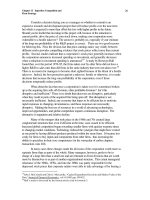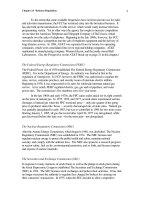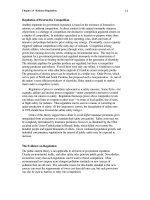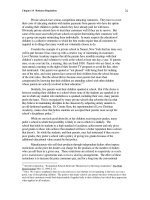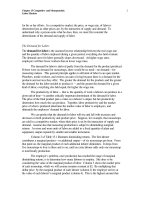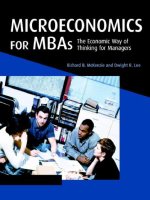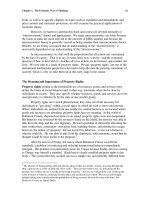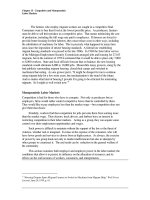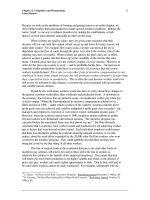Microeconomics for MBAs 2
Bạn đang xem bản rút gọn của tài liệu. Xem và tải ngay bản đầy đủ của tài liệu tại đây (139.03 KB, 10 trang )
Chapter 1. The Economic Way of Thinking
10
book, as well as in specific chapters on topics such as regulation and deregulation, and
price controls and consumer protection, we will examine the practical applications of
economic theory.
However, we hasten to add that this book and course are devoted primarily to
“microeconomic” theory and applications. We make microeconomics our focus because
the issues at stake are more relevant to the interests of MBA students and because the
microeconomic theory is generally viewed as being sounder than macroeconomic theory.
Besides, we are firmly convinced that an understanding of the “macroeconomy” is
necessarily dependent on an understanding of the “microeconomy.”
In microeconomics we start with the proposition that all actions are constrained
by the fact of scarcity. That is to say, in some basic way, scarcity—and the economic
question of how to deal with it—touches all of us in how we do business and conduct our
lives. We now turn to a study of property rights. Private “property rights” are one of the
institutional mechanisms people have devised to help alleviate the pressing constraints of
scarcity, which is why we take them up at this early stage in the course.
The Meaning and Importance of Property Rights
Property rights pertain to the permissible use of resources, goods, and services; they
define the limits of social behavior and, in that way, determine what can be done by
individuals in society. They also specify whether resources, goods, and services are to be
used privately or collectively by the state or any smaller group.
Property rights are a social phenomenon; they arise out of the necessity for
individuals to “get along” within a social space in which all wish to move and interact.
Where individuals are isolated from one another by natural barriers or are located where
goods and resources are abundant, property rights have no meaning. In the world of
Robinson Crusoe, shipwrecked alone on an island, property rights were inconsequential.
His behavior was restricted by the resources found on the island, the tools he was able to
take from the ship, and his own ingenuity. He had a problem of efficiently allocating his
time within these constraints—procuring food, building shelter, and plotting his escape;
however, the notion of “property” did not restrict his behavior—it was not a barrier to
what he could do. He was able to take from the shipwreck, with immunity, stores that he
thought would be most useful to his purposes.
5
After the arrival of Friday, the native whom Robinson Crusoe saved from
cannibals, a problem of restricting and ordering interpersonal behavior immediately
emerged. The problem was particularly acute for Crusoe because Friday, prior to coming
to Tibago, was himself a cannibal. (Each had to clearly establish property rights to his
body.) The system that they worked out was a simple one, not markedly different from
5
The absence of human beings affected also his idea of what was useful. Crusoe, in going through the
ship, came across a coffer of gold and silver coins: “Thou art not worth to me, no, not taking off the
ground; one of these knives is worth all this heap [of gold].” At first, he evaluated the cost of taking the
coins in terms of what he could take in their place and decided to leave them. But on second thought,
perhaps taking into consideration the probability of being rescued, he took the coins with him! See
Robinson Crusoe by Daniel Defoe.
Chapter 1. The Economic Way of Thinking
11
that between Crusoe and “Dog.” Crusoe essentially owned everything. Their
relationship was that of master and servant, Crusoe dictating to Friday how the property
was to be used.
The notion of property rights is broadly conceived by economists. Property rights
are most often applied to discussions of real estate and personal property (bicycles,
clothes, etc.); they are also applicable to what people can do with their minds, their ability
to speak, how they wear their hair, and if and when they must wear their shoes.
In common speech, we frequently speak of someone owning this land, that house,
or these bonds. This conventional style undoubtedly is economical from the viewpoint of
quick communications, but it masks the variety and complexity of the ownership
relationship. What is owned are rights to use resources, including one’s body and mind,
and these rights are always circumscribed, often by prohibition of certain actions. To
“own land” usually means to have the right to till (or not to till) the soil, to mine the soil,
to offer those rights for sale, etc., but not to have the right to throw soil at a passerby, to
use it to change the course of a stream, or to force someone to buy it. What are owned
are socially recognized rights of action.
6
Property rights are not necessarily distributed equally, meaning that people do not
always have the same rights to use the same resources. Students may have the right to
use their voices (i.e., a resource) to speak with friends in casual conversation in the
hallways of classroom buildings, but they do not, generally speaking, have the right to
disrupt an English class with a harangue on their political views. However, the English
professor, although his behavior is circumscribed, has the right to “allow” his or her
political views to filter into the English lectures. And if the President of the United States
walked into the same English class and began speaking extemporaneously on his (or her)
political views, it is not likely that anyone would object. A person has the right to go
without shoes on a beach, but one does not always have the right to enter a restaurant
without shoes. On the other hand, the restaurant owner’s best friend may have that right.
By the same token, although undergraduate students generally pay a fraction of their
educational expenses at state universities, they have the right to university facilities such
as tennis courts and the university bookstore, but nonstudent taxpayers do not have the
same rights to these facilities.
In other words, property rights can be recast in terms of the behavioral rules,
which effectively limit and restrict our behavior. Behavioral rules determine what rights
we have with regard to the use of resources, goods, and services. The rights we have may
be the product of the legislative process and may be enforced by a third party: usually the
third party is the government or, more properly, the agents of government. In this case
property rights emerge from laws.
On the other hand, rules that establish rights may not have third-party
enforcement. In this case they carry weight in the decisions of individuals simply
because individuals recognize and respect behavioral limits for themselves and others.
They may do this because of the value they attach to “living up” to their contractual
agreements, which may be implied in their associations with others, and because their
6
Armen A. Alchian and Harold Demsetz, “The Property Rights Paradigm,” Journal of Economic History,
vol. 33, p. 17, March 1973.
Chapter 1. The Economic Way of Thinking
12
own rights may be violated if they violate the rights of others. Two neighbors may
implicitly agree to certain modes of behavior, such as not mowing their lawns on Sunday
mornings or playing their stereo equipment late at night.
7
Their behavior may be in
recognition of what it means to be a “good neighbor” and of what life can be like if limits
to their behavior are not observed. The neighbor who starts his mower early Sunday
morning may hear music late at night or may find his rights invaded in other ways. More
will be said on this, but for now we mean only to point out that the behavior of each
through “offensive and counteroffensive” maneuvers may deteriorate into a state in
which both parties are worse off than they would have been if restrictions on their own
behavior were commonly observed. From this we see the bases for behavioral rules or,
what amounts to the same thing, property rights.
Property rights are important to any inquiry of social order because it is on the
basis of such rights that the terms individual and state are given social meaning, that
actions are delimited, and that a specific social order will emerge. The existing property
rights structure is predicated upon specific social and physical conditions. Changes in
those conditions can cause a readjustment in the nature of social order.
Property Rights and the Market
In the private market economy people are permitted to initiate trades with one another.
Indeed, when people trade, they are actually trading “rights” to goods and services or to
do certain things. For example, when a person buys a house in the market, he is actually
buying the right to live in the house under certain conditions, for example, as long as he
does not disturb others. This market economy is predicated upon establishing patterns of
private property rights; those patterns have legitimacy because of enforcement by
government and, perhaps just as important, because of certain precepts regarding the
limits of individual behavior that are commonly accepted and observed.
8
Without
recognized property rights there would be nothing to trade—no market.
How dependent are markets on government enforcement for the protection and
legitimacy of private property rights? Our answer must of necessity be somewhat
speculative. We know that markets existed in the “Old West” when formally instituted
governments were nonexistent. Further, it is highly improbable that any government can
be so pervasive in the affairs of people that it can be the arbiter of all private rights.
Cases in which disputes over property rights within college dormitories are settled by
student councils are relatively rare, and the disputes that end up in the dean’s office or at
police headquarters are rarer still. Most conflicts over property rights are resolved at a
local level, between two people, and many potential disputes do not even arise because of
generally accepted behavioral limits.
Finally, the concept of property rights helps make clear the relationship between
the public and private sectors of the economy—that is, between that section of the
7
This is an example used by James M. Buchanan, The Limits of Liberty (Chicago: University of Chicago
Press, 1975), p. 20.
8
In addition, there is considerable private enforcement of property rights. Almost all people take some
measures to secure their own property. They put locks on their doors, leave lights on at night, and alert
their neighbors to take their newspapers in when they are out of town.
Chapter 1. The Economic Way of Thinking
13
economy organized by collective action through government and that section which is
organized through the actions of independent individuals. When government regulates
aspects of the market, it redefines behavioral limits (in the sense that people can no
longer do what they once could) and can be thought of as realigning the property rights
between the private and public spheres. When the government imposes price ceilings on
goods and services, as it did during the summer of 1971, it is redefining the rights that
sellers have with regard to the property they sell. One of the purposes of economics is to
analyze the effect that a realignment of property rights has on the efficiency of
production.
Anarchy: A State of Disorder
Property rights are so much a part of our everyday experience that we are inclined to
think of them as being “natural,” a part of our birthright. The Declaration of
Independence speaks of “certain unalienable rights.” Indeed, it is hard to imagine a
world in which people interact within a defined social space without the existence of
property rights. The purpose of this section is to envision such a state in order to gain
some insight into the origins of property rights and, therefore, social order.
Thomas Hobbes, a seventeenth-century political scientist philosopher, envisioned
a state in which there was a complete absence of property rights, either those rights that
have legitimacy because of their social acceptability or those that exist because of legal
enforcement. He called this “the state of nature,” and his analysis was not very attractive.
Because Hobbes gave very little credence to social acceptance as a basis for property
rights, his attention was on the role of the state. He believed that “during the time men
live without a common Power to keep them in awe,” every man will be pitted against
another in continual struggle for dominance and protection. Life will be “solitary, poore,
nasty, brutish, and short.” Where there is no state, he argued, there will be no law and
therefore, “no Property ... no Mine and Thine distinct, but only that to be every man’s that
he can get, and for so long as he can keep it.”
9
One of Hobbes’ purposes in writing Leviathan was to justify the sovereign state
as an absolutely necessary political entity. He tried to convince his contemporaries of the
potential for conflict among men without the state; that it is necessary to hand over
considerable political power to the state in order that internal conflicts may be minimized.
He argued that it is in man’s self-interest to swear full allegiance to the state.
In order to make his argument as convincing as possible, it was somewhat natural
for Hobbes to describe “the state of nature” in the worst possible terms. One can accept
the criticism that Hobbes exaggerated the need for the state without ignoring a
cornerstone of his argument: Without legally defined property rights, there is
considerable potential for conflict among men. The life of man in the state of nature may
not invariably be “solitary, poore, nasty, brutish, and short,” but it may be markedly less
comfortable without property rights than with them.
9
Thomas Hobbes, Leviathan, ed. By C.B. Macpherson [Baltimore, Md.: Penguin Books, Inc., 1968 (first
published 1651], pp. 185–88.
Chapter 1. The Economic Way of Thinking
14
In an idealized world in which people are fully considerate of each other’s
feelings and adjust and readjust their behavior to that of others without recourse to
anything resembling a dividing line between “mine” and “thine,” property rights are no
more necessary than they were for Robinson Crusoe alone on Tibago. But in the world
as it now exists, there is the potential for conflict. Granted, the potential may not be
present in all our interpersonal experiences. People have interests that, for all practical
purposes, are independent of one another, and many of our interests are perfectly
congruent with the interests of those around us. However, people have spheres of
interests (described for two people by the circle in Figure 1.1) that extend outward from
themselves and that intersect with the interests of others. A basic axiom of behavior (one
to be developed in greater detail later) is that most people want more than they have,
which means they have an interest in, or can benefit from, that which others have. In
other words, they have competing interests—or, in terms of Figure 1.1, areas where their
spheres of interests intersect. It is here that the potential for conflict arises, that a
dividing line between “mine” and “thine” must be drawn.
Figure 1.1 Individuals have spheres of interest,
which are illustrated, by the two circles. The
intersection of the two circles represents the arc of
potential conflict between two individuals; it is the
area within which property rights (or behavioral
limits) must be established.
Children at play provide us with a reasonably clear illustration of the absence of
and potential for conflict among people in the larger community. Children can often play
together for long periods of time without conflict. They each have interests that do not
invade the interests of others (which may be described by the clear portions of the circles
in Figure 1.1); for example, one may want to play with a truck, one with a bucket and
shovel, and another with toy cowboys. For periods, their behavior may approximate the
idealized society mentioned above. On the other hand, when two children want to play
with the same toy or play the same role of mother or father in their game of “house,” or
when one child wants to take over the entire sandbox, conflict is revealed, first with harsh
words, possibly in fights, leading to a breakdown of their social interaction—play.
Conflict or the potential for conflict can be alleviated by the development of
property rights, held either communally, by the state, or by private individuals. These
rights can be established in ways that are similar but which can be conceptually
distinguished: (1) voluntary acceptance of behavioral norms with no third-party enforcer,
such as the police and courts, and (2) the specification of rights in a legally binding
“social contract,” meaning that a third-party enforcer is established. Most of what we say
for the remainder of this chapter applies to both modes of establishing rights. However,
for reasons developed later in the book, the establishment of rights through voluntary
